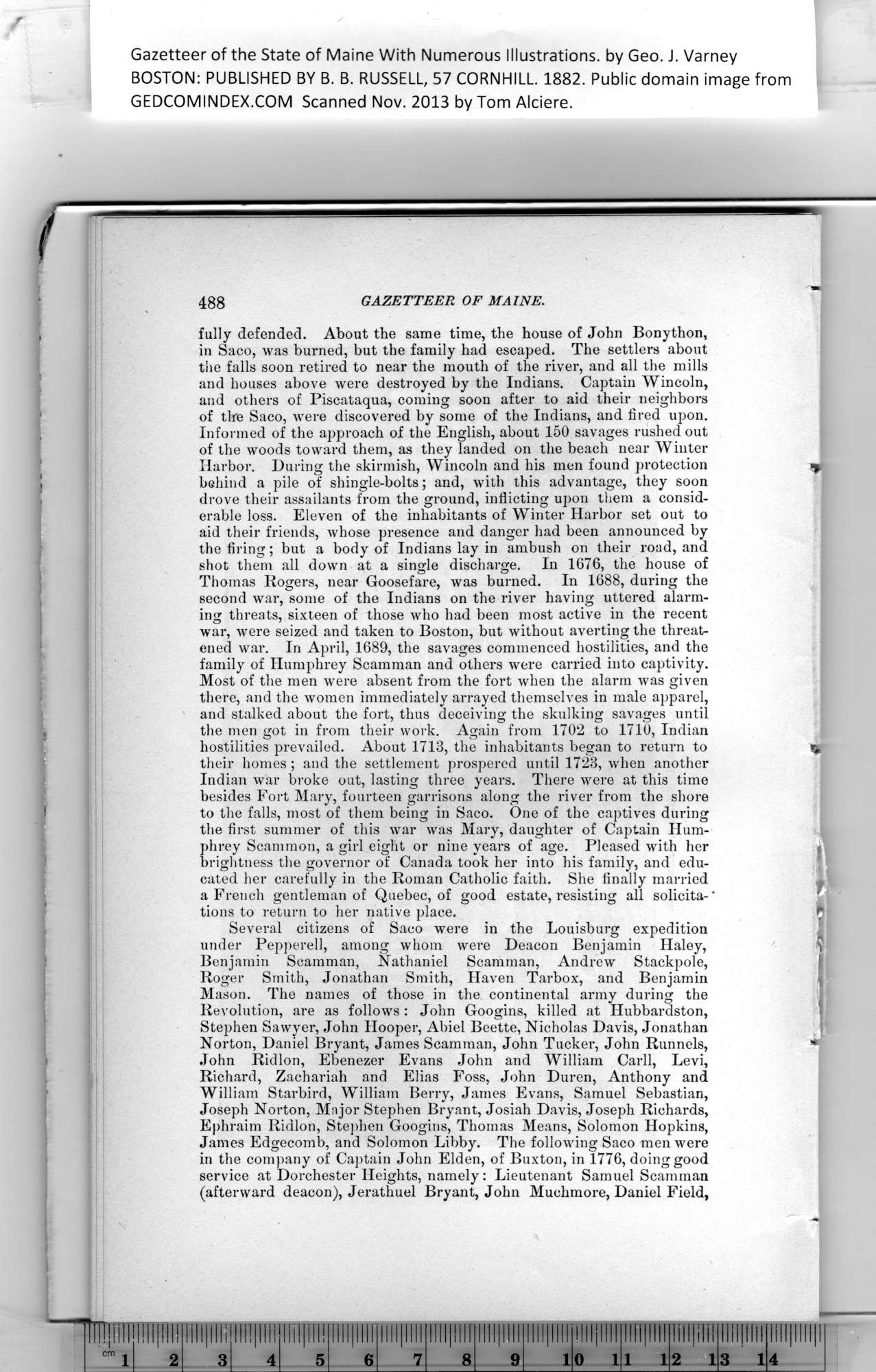|
Gazetteer of the State of Maine With Numerous Illustrations, by Geo. J. Varney
BOSTON: PUBLISHED BY B. B. RUSSELL, 57 CORNHILL. 1882. Public domain image from
(
GAZETTEER OF MAINE.
fully defended. About the same time, the house of John Bonython,
in Saco, was burned, but the family had escaped. The settlers about
tiie falls soon retired to near the mouth of the river, and all the mills
and houses above were destroyed by the Indians. Captain Wincoln,
and others of Piscataqua, coming soon after to aid their neighbors
of the Saco, were discovered by some of the Indians, and fired upon.
Informed of the approach of the English, about 150 savages rushed out
of the woods toward them, as they landed on the beach near Winter
Harbor. During the skirmish, Wincoln and his men found protection
behind a pile of shingle-bolts; and, with this advantage, they soon
drove their assailants from the ground, inflicting upon them a consid-
erable loss. Eleven of the inhabitants of Winter Harbor set out to
aid their friends, whose presence and danger had been announced by
the firing; but a body of Indians lay in ambush on their road, and
shot them all down at a single discharge. In 1676, the house of
Thomas Rogers, near Goosefare, was burned. In 1688, during the
second war, some of the Indians on the river having uttered alarm-
ing threats, sixteen of those who had been most active in the recent
war, were seized and taken to Boston, but without averting the threat-
ened war. In April, 1689, the savages commenced hostilities, and the
family of Humphrey Scamman and others were carried into captivity.
Most of the men were absent from the fort when the alarm wras given
there, and the women immediately arrayed themselves in male apparel,
and stalked about the fort, thus deceiving the skulking savages until
the men got in from their work. Again from 1702 to 1710, Indian
hostilities prevailed. About 1718, the inhabitants began to return to
their homes ; and the settlement prospered until 1723, when another
Indian war broke out, lasting three years. There were at this time
besides Fort Mary, fourteen garrisons along the river from the shore
to the falls, most of them being in Saco. One of the captives during
the first summer of this war was Mary, daughter of Captain Hum-
phrey Scammon, a girl eight or nine years of age. Pleased with her
brightness the governor of Canada took her into his family, and edu-
cated her carefully in the Roman Catholic faith. She finally married
a French gentleman of Quebec, of good estate, resisting all solicita-’
tions to return to her native place.
Several citizens of Saco were in the Louisburg expedition
under Pepperell, among whom were Deacon Benjamin Haley,
Benjamin Scamman, Nathaniel Scamman, Andrew Stackpole,
Roger Smith, Jonathan Smith, Haven Tarbox, and Benjamin
Mason. The names of those in the continental army during the
Revolution, are as follows : John Googins, killed at Hubbardston,
Stephen Sawyer, John Hooper, Abiel Beette, Nicholas Davis, Jonathan
Norton, Daniel Bryant, James Scamman, John Tucker, John Runnels,
John Ridlon, Ebenezer Evans John and William Carll, Levi,
Richard, Zachariah and Elias Foss, John Duren, Anthony and
William Starbird, William Berry, James Evans, Samuel Sebastian,
Joseph Norton, Major Stephen Bryant, Josiah Davis, Joseph Richards,
Ephraim Ridlon, Stephen Googins, Thomas Means, Solomon Hopkins,
James Edgecomb, and Solomon Libby. The following Saco men were
in the company of Captain John Elden, of Buxton, in 1776, doing good
service at Dorchester Heights, namely: Lieutenant Samuel Scamman
(afterward deacon), Jerathuel Bryant, John Muchmore, Daniel Field,
PREVIOUS PAGE ... NEXT PAGE
This page was written in HTML using a program written in Python 3.2
|
